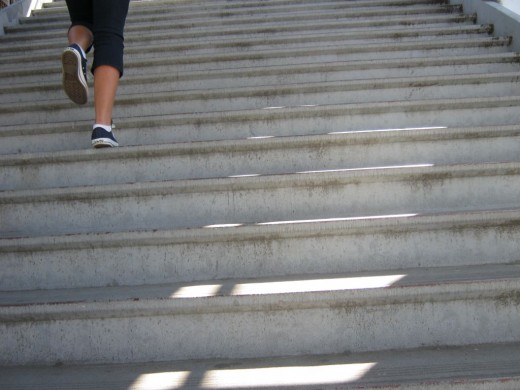
A student runs up stairs at Monroe Clark Middle School in City Heights. | Photo Credit: Cecia, The AjA Project
By Megan Burks
A new law aiming to limit school discipline measures that take students out of class went into effect Jan. 1. But new data from the California Department of Education shows districts have already chipped away at suspension and expulsion rates.
The number of students suspended from school temporarily was down 15.2 percent during the 2013-14 school year compared to the previous year. Expulsions, or permanent removal from campus, were down 20 percent last school year.
San Diego schools mirror the trend, and even eclipse the statewide numbers. Students in San Diego County were less likely than their peers in the state to be suspended – 3.4 percent of students were taken out of class compared to 4.4 percent statewide.
And with a rate of 0.1 percent, San Diego kids were just as likely as those in the state to be expelled. (The state education code requires administrators apply the highest punishment if students commit serious offenses such as carrying a firearm and selling drugs.)
San Diego’s largest school district, San Diego Unified, saw a slight decrease in its suspension rate, from 4.8 percent in 2012-13 to 4.2 percent.
San Diego’s lowest suspension and expulsion rates were among its elementary school districts. Fallbrook Union High School District and the Santee School District had the highest suspension rate – 6.5 percent – and Fallbrook and the Grossmont Unified School District had the highest expulsion rate – 0.5 percent.
But the Fallbrook and Grossmont numbers are down from the previous year. Grossmont Superintendent Ralf Swenson said the decrease is the result of a deliberate effort to train teachers in new classroom management strategies.
READ: The Secret to Fixing School Discipline Problems: Change the Behavior of Adults
“We’re really proud of the pattern we’re seeing and the incredible difference it’s making,” Swenson said. “We’ve seen an improvement in our attendance rates as a result of this and we believe it’s also impacting learning.”
Swenson said the district is already on track for another suspension rate decrease. In 2013-14, schools in the district covering La Mesa, El Cajon, Lakeside and Santee suspended 981 students, Swenson said. Now halfway through this school year, teachers there have suspended 393 kids.
Fallbrook got a new superintendent in September. Hugo Pedroza said he’s working to change the culture on his campuses.
“When (students are) asked to attend a particular intervention and they don’t, the tendency here has been to try to enforce that with suspension,” Pedroza said. “Of course, it just exacerbates the problem, so we are definitely looking at more proactive, positive ways of getting folks to be engaged with school.”
Pedroza said he wants to create a better opportunity for staff to intervene before students act out by boosting counseling and programs that can get at the causes of their poor behavior or better engage them in school. He said suspension rates are much higher for freshmen, so he also wants to focus on better helping them transition into high school.
Assembly Bill 420, which went into effect this year, prevents administrators from suspending children from kindergarten to third grade. It also ends expulsions at all levels for “willful defiance.” The category has come under fire in recent years because it’s a catchall for minor classroom disruptions and disproportionately affects students of color.
Advocates pushing to soften school discipline say suspensions and expulsions put kids on the path to dropping out and, later, becoming incarcerated.
